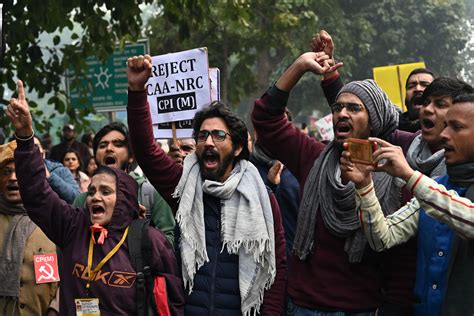India Protests

The year 2023 has witnessed a surge of protests across India, with citizens taking to the streets to voice their concerns and demand change. From farmer rallies to student movements and nationwide strikes, these protests have highlighted various social, political, and economic issues. In this comprehensive analysis, we delve into the world of India's protests, exploring their triggers, impact, and potential long-term effects on the nation's future.
The Rise of India’s Protest Culture

India has a rich history of protest movements, dating back to its struggle for independence. However, the past decade has seen a notable increase in the frequency and diversity of protests. Several factors have contributed to this trend, including the rise of social media as a powerful tool for organizing and spreading awareness, growing socio-economic disparities, and a perceived lack of effective governance.
One of the most prominent protest movements in recent years was the Farmers' Protest, which began in 2020. Farmers across India, especially in the northern states, rallied against three agricultural reform bills introduced by the government. These bills, according to the farmers, threatened their livelihoods and favored corporate interests. The protests gained international attention and continued for over a year, with farmers setting up camps on the outskirts of Delhi, the capital city.
Another significant protest movement was the Students' Uprising of 2019. Triggered by a controversial citizenship law, students from various universities across the country took to the streets, leading to clashes with police forces. The movement highlighted the growing concern among youth regarding issues of citizenship, religious freedom, and the role of the state in governing personal liberties.
The Impact of Protests on Indian Society

India’s protests have had a profound impact on the nation’s social fabric. They have served as platforms for marginalized communities to voice their concerns and demand equal rights. For instance, the Dalit Protest movement, led by members of the Dalit community (formerly known as ‘untouchables’), has brought attention to issues of caste discrimination and violence. These protests have forced society to confront its deep-rooted biases and encouraged a national dialogue on social justice.
Protests have also played a crucial role in shaping public opinion and influencing policy decisions. The Environmental Protests against industrial projects that threaten natural habitats and indigenous communities have often resulted in the shelving of projects or the implementation of stricter environmental regulations. Similarly, the Women's March protests have brought attention to issues of gender inequality, sexual violence, and the need for stronger legal protections for women.
Furthermore, protests have acted as catalysts for social change, inspiring movements for civil rights, labor rights, and LGBTQ+ rights. They have also led to the emergence of new political ideologies and parties, challenging the traditional two-party system in India.
The Economic and Political Implications
India’s protests have not only had social implications but have also impacted the country’s economic and political landscape. Large-scale protests can disrupt economic activities, especially in sectors like agriculture and trade, leading to significant financial losses. For instance, the Farmer’s Protest caused disruptions in the supply chain of agricultural products, affecting both farmers and consumers.
From a political perspective, protests can be seen as a barometer of public sentiment. They provide a platform for citizens to express their dissatisfaction with the government's policies and performance. The frequency and intensity of protests can influence electoral outcomes and force political parties to reevaluate their strategies and policies.
However, the government's response to protests has often been a subject of debate. While peaceful protests are protected under the Indian Constitution, instances of police brutality and the use of excessive force have been reported. This has led to international criticism and calls for reforms in the country's policing and governance systems.
A Glimpse into the Future
The future of India’s protest movements is hard to predict. However, given the country’s diverse population, growing socio-economic disparities, and the increasing role of social media, it is likely that protests will continue to be a significant part of India’s political landscape.
One potential outcome is the emergence of more organized and structured protest movements, with clear demands and strategies. This could lead to more effective negotiations between protesters and the government, potentially resulting in meaningful policy changes. On the other hand, the government may adopt more stringent measures to curb protests, which could lead to further tensions and conflicts.
The international community also plays a crucial role in shaping the future of India's protest movements. Global attention and support can amplify the voices of protesters and pressure the Indian government to address their concerns. However, external interference can also lead to geopolitical tensions and complicate the situation.
In conclusion, India's protests are a reflection of the country's complex social, economic, and political landscape. They provide a platform for citizens to exercise their democratic rights and demand change. While protests have had a significant impact on various aspects of Indian society, their long-term effects and future trajectory remain uncertain. Only time will tell how these movements will shape India's future.
FAQs
What are some common triggers for protests in India?
+Protests in India are often triggered by a range of issues, including government policies (such as agricultural reforms or citizenship laws), social injustices (like caste discrimination or gender inequality), environmental concerns, and labor rights violations.
How have protests influenced the Indian government’s policies?
+Protests have forced the Indian government to reevaluate its policies and, in some cases, led to policy changes. For instance, the Farmer’s Protest movement resulted in the repeal of three agricultural reform bills. Protests have also influenced the government’s approach to issues like environmental protection and women’s rights.
What is the role of social media in India’s protest movements?
+Social media has played a crucial role in India’s protest movements by facilitating communication, organization, and awareness. It has allowed protesters to connect, share information, and coordinate their actions, even across vast distances. Social media platforms have also served as spaces for public discourse and the exchange of ideas.



